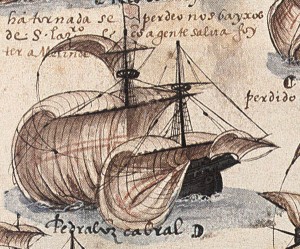Â
 A great story beamed across my desk this week—a story that initially aroused my deep suspicions and has now completely captured my imagination.  It’s a story about a perilous sea route; a sleek Renaissance ship laden with astrolabes, gold coins and elephant ivory; and a modern quest for diamonds off the Namibian coast. It’s a story that could easily have ended in disaster for archaeologists and triumph for treasure hunters—but didn’t.  It’s such a rare kind of story that I’d like to tell you about it.Â
A great story beamed across my desk this week—a story that initially aroused my deep suspicions and has now completely captured my imagination.  It’s a story about a perilous sea route; a sleek Renaissance ship laden with astrolabes, gold coins and elephant ivory; and a modern quest for diamonds off the Namibian coast. It’s a story that could easily have ended in disaster for archaeologists and triumph for treasure hunters—but didn’t.  It’s such a rare kind of story that I’d like to tell you about it.Â
Last April, geologists working for the Namdeb Diamond Corp along the coast of Namibia, in southwestern Africa, spied something unusual in a newly exposed stretch of seabed: copper ingots and cylindrical objects resembling cannon barrels. The company—a joint venture between the Namibian government and De Beers—had just constructed a massive earthen dike in the area and drained the seabed at great cost to search for gems.  But the Namdeb geologists halted the work and reported their find to the company’s archaeological consultant, Dieter Noli.  Noli, in turn, swiftly identified the finds as detritus from a European shipwreck and mounted a recovery.
Two days ago, Namibia’s information ministry announced that the mystery ship was a 16th century Portuguese Indiaman bound for Asia carrying thousands of gold and silver coins, several tons of copper ingots, and more than 50 elephant tusks. The vessel bristled with bronze cannons to defend its treasures from pirates.  Â
Here’s the thing. The Portuguese Indiamen were the space shuttles of Renaissance Europe—sleek wooden ships designed to sail what was then the longest and most dangerous sea route in the world, from Portugal to India. Indeed Indiamen seem to have been the most technologically sophisticated sailing ships of their time, three and four-storied vessels capable of surviving both the ice storms of the African cape and the cyclones of Asia. But archaeologists still know relatively little about the evolving design of these vessels.Â
The reason for this is very simple. The Indiamen were treasure ships.  They ferried the wealth of Asia—gold bullion, diamonds, sapphires and many other valuables—to the Portuguese court and Portuguese merchants.  So for years now, treasure hunters have rapaciously targeted the wrecks of the Indiamen. One company has even struck a deal with the government of Mozambique to obtain exclusive rights to its shipwrecks in exchange for a share of the loot.  Since then it has been selling off the finds from the Indiamen that wrecked along Mozambique shores.  Â
When I first read about the Namibian wreck, I worried that this was just another sorry treasure hunt dressed up as science. Maritime looters, after all, are very fond of disguising their operations as legitimate archaeology. But when I emailed Filipe Castro, a nautical archaeologist at Texas A & M University and one of the world’s great authorities on the Portuguese Indiamen, yesterday, he told me that he had flown out to Namibia to see the wreck site himself, and found it in the hands of serious, competent archaeologists.Â
What a stroke of luck this is for science and archaeology.  Now we all have a chance to learn something new and important about the wonders of the lost Indiamen. Â
This entry was posted by Heather Pringle on
Friday, September 19, 2008.
Discussion of this blog entry is now closed.
Comments posted here do not represent the views or policies of the Archaeological Institute of America.

